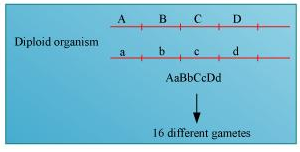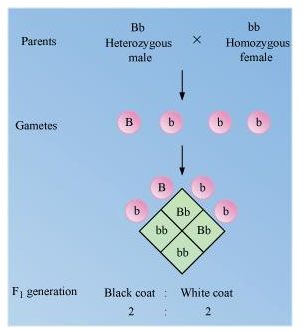Chapter 4 : Principles of Inheritance And Variation
Biology
Question1. Mention the advantages of selecting pea plant for experiment by Mendel.
Solution :
Mendel selected pea plants to carry out his study on the inheritance of characters from parents to offspring.
He selected a pea plant because of the following features.
- Peas have many visible contrasting characters such as tall/dwarf plants, round/wrinkled seeds, green/yellow pod, purple/white flowers, etc.
- Peas have bisexual flowers and therefore undergo self pollination easily. Thus, pea plants produce offsprings with same traits generation after generation.
- In pea plants, cross pollination can be easily achieved by emasculation in which the stamen of the flower is removed without affecting the pistil.
- Pea plants have a short life span and produce many seeds in one generation.
Question2. Differentiate between the following −
(a) Dominance and Recessive
(b) Homozygous and Heterozygous
(c) Monohybrid and Dihybrid.
Solution :
(a) Dominance and Recessive
| Dominance | Recessive | |
| 1. | A dominant factor or allele expresses itself in the presence or absence of a recessive trait. | A recessive trait is able to express itself only in the absence of a dominant trait. |
| 2. | For example, tall plant, round seed, violet flower, etc. are dominant characters in a pea plant. | For example, dwarf plant, wrinkled seed, white flower, etc. are recessive traits in a pea plant. |
(b) Homozygous and Heterozygous
| Homozygous | Heterozygous | |
| 1. | It contains two similar alleles for a particular trait. | It contains two different alleles for a particular trait. |
| 2. | Genotype for homozygous possess either dominant or recessive, but never both the alleles. For example, RR or rr | Genotype for heterozygous possess both dominant and recessive alleles. For example, Rr |
| 3. | It produces only one type of gamete. | It produces two different kinds of gametes. |
(c) Monohybrid and Dihybrid
| Monohybrid | Dihybrid | |
| 1. | Monohybrid involves cross between parents, which differs in only one pair of contrasting characters. | Dihybrid involves cross between parents, which differs in two pairs of contrasting characters. |
| 2. | For example, the cross between tall and dwarf pea plant is a monohybrid cross. | For example, the cross between pea plants having yellow wrinkled seed with those having green round seeds is a dihybrid cross. |
Question3. A diploid organism is heterozygous for 4 loci, how many types of gametes can be produced?
Solution :
By applying the formula 2n (where n = number of loci)
4 loci can produce = 24 = 16 types of gametes.

Question4.Explain the Law of Dominance using a monohybrid cross.
Solution :
Law of Dominance states that when two genes are present in an organism then dominant gene expresses itself and recessive gene does not show its effect and remain hidden.
When a cross pollination experiments is conducted between two organisms taking a single contrasting character at a time it is called monohybrid cross.
When two pea plants, one is pure tall (TT) and other is pure dwarf (tt) are crossed. All pants in F1 generation were found to be Tal l(TT). When these tall plants (Tt) were self fertilized, both the tall and dwarf seeds appeared in F2 generation in 3: 1 ratio. Hence, in F1generation, the dominant character (Tall) appeared and the recessive character (dwarf) got suppressed, which reappeared in F2 generation. Thus, this monohybrid cross explains Law of Dominance.

Question5. Define and design a test − cross?
Solution :
A test cross is one in which an individual with an unknown dominant phenotype is crossed with a recessive individual for that trait. It is used to determine whether the individual is homozygous or heterozygous for a trait.
If the unknown is homozygous tall (TT), then crossing with dwarf recessive (tt) gives all tall offspring (Tt). If the unknown is heterozygous tall (Tt), then crossing with dwarf results in 50% tall (Tt) and 50% dwarf (tt) progeny.

Question6. Using a Punnett square, work out the distribution of phenotypic features in the first filial generation after a cross between a homozygous female and a heterozygous male for a single locus.
Solution :
In guinea pigs, heterozygous male with black coat colour (Bb) is crossed with the female having white coat colour (bb). The male will produce two types of gametes, B and b, while the female will produce only one kind of gamete, r. The genotypic and phenotypic ratio in the progenies of F1 generation will be same i.e., 1:1.

Question7. When a cross in made between tall plants with yellow seeds (TtYy) and tall plant with green seed (TtYy), what proportions of phenotype in the offspring could be expected to be
(a) Tall and green.
(b) Dwarf and green.
Solution :
A cross between tall plant with yellow seeds and tall plant with green seeds will produce
(a) three tall and green plants
(b) one dwarf and green plant

Question8. Two heterozygous parents are crossed. If the two loci are linked what would be the distribution of phenotypic features in F1 generation for a dihybrid cross?
Solution :
If two loci are linked, they lie close on the same locus of a chromosome, they would separate. However, the chromosomes do segregate and end up in different gametes.

Question9. Briefly mention the contribution of T.H. Morgan in genetics.
Solution :
TH Morgan’s contribution in genetics are
- Morgan contributed to the understanding of sex-linked traits.
- He carried out several experiments on fruit flies and his dihybrid crosses revealed that genes for some traits did not segregate independently and the F2 ratio was a lot different from 9:3:3:1.
- He inferred that when two genes were situated on the same chromosome, the proportions of parental gene combinations were significantly higher than the non-parental type.
- He established the principle of linkage crossing over, sex-linked inheritance and discovered the relation.
- He established the technique of chromosome mapping.
- He observed and worked on mutation..
Question10. What is pedigree analysis? Suggest how such an analysis, can be useful.
Solution :
Pedigree analysis is a record of occurrence of a trait in several generations of a family. It is based on the heritability of certain characteristic features in families.
Its usefulness are:
- It shows the origin of a trait and flow of that trait in a family.
- It is useful in knowing the possibility of expressive or recessive allele which may cause genetic disorder, such as colour blindness.
- It predicts the harmful effects of marriage between close relatives.
- It helps in genetic counselling to avoid disorders in children.
Question11. How is sex determined in human beings?
Solution :
Human beings have 23 pairs of chromosomes in which 22 pairs of autosomes and one pair of sex chromosomes. The females have a pair of XX-chromosomes (homogametic) and the males XY (heterogametic) composition. The sex of the baby is determined by the type of male gamete that fuses with the female gamete. If the fertilizing sperm contains X chromosome, then the baby produced will be a girl and if the fertilizing sperm contains Y chromosome, then the baby produced will be a boy.

Question12. A child has blood group O. If the father has blood group A and mother blood group B, work out the genotypes of the parents and the possible genotypes of the other offsprings.
Solution :
The blood group characteristic in humans is controlled by three set of alleles, namely, IA, IB, and i. The alleles, IA and IB, are equally dominant whereas allele, i, is recessive to the other alleles. The individuals with genotype, IA IA and IA i, have blood group A whereas the individuals with genotype, IB IB and IB i, have blood group B. The persons with genotype IA IB have blood group AB while those with blood group O have genotype ii.
Hence, if the father has blood group A and mother has blood group B, then the possible genotype of the parents will be
Father Mother
IA IA or IA i IB IB or IB i
A cross between homozygous parents will produce progeny with AB blood group.

A cross between heterozygous parents will produce progenies with AB blood group (IAIB) and O blood group (ii).

Question13. Explain the following terms with example
(a) Co-dominance
(b) Incomplete dominance
Solution :
(a) Co-dominance
Co-dominance is the phenomenon in which both the alleles of a contrasting character are expressed in heterozygous condition. Both the alleles of a gene are equally dominant. ABO blood group in human beings is an example of co-dominance. The blood group character is controlled by three sets of alleles, namely, IA, IB, and i. The alleles, IA and IB, are equally dominant and are said to be co-dominant as they are expressed in AB blood group. Both these alleles do not interfere with the expression of each other and produce their respective antigens. Hence, AB blood group is an example of co-dominance.
Incomplete dominance: Incomplete dominance is a phenomenon in which one allele shows incomplete dominance over the other member of the allelic pair for a character. For example, a monohybrid cross between the plants having red flowers and white flowers in Antirrhinum species will result in all pink flower plants in F1 generation. The progeny obtained in F1 generation does not resemble either of the parents and exhibits intermediate characteristics. This is because the dominant allele, R, is partially dominant over the other allele, r. Therefore, the recessive allele, r, also gets expressed in the F1 generation resulting in the production of intermediate pink flowering progenies with Rr genotype.

Question14. What is point mutation? Give one example.
Solution :
Point mutation is a change in a single base pair of DNA by substitution, deletion, or insertion of a single nitrogenous base. An example of point mutation is sickle cell anaemia. It involves mutation in a single base pair in the beta-globin chain of haemoglobin pigment of the blood. Glutamic acid in short arm of chromosome II gets replaced with valine at the sixth position.
Question15. Who had proposed the chromosomal theory of inheritance?
Solution :
Sutton and Boveri proposed the chromosomal theory of inheritance in 1902. They linked the inheritance of traits to the chromosomes.
Question16. Mention any two autosomal genetic disorders with their symptoms.
Solution :
Two autosomal genetic disorders are as follows.
Sickle cell Anaemia: It is an autosomal linked recessive disorder, which is caused by point mutation in the beta-globin chain of haemoglobin pigment of the blood. The disease is characterized by sickle shaped red blood cells, which are formed due to the mutant haemoglobin molecule. The disease is controlled by HbA and HbS allele. The homozygous individuals with genotype, HbS HbS, show the symptoms of this disease while the heterozygous individuals with genotype, HbA HbS, are not affected. However, they act as carriers of the disease.
Symptoms: Rapid heart rate, breathlessness, delayed growth and puberty, jaundice, weakness, fever, excessive thirst, chest pain, and decreased fertility are the major symptoms of sickle cell anaemia disease.
Down’s syndrome: It is an autosomal disorder that is caused by the trisomy of chromosome 21.
Symptoms: The individual is short statured with round head, open mouth, protruding tongue, short neck, slanting eyes, and broad short hands. The individual also shows retarded mental and physical growth.

